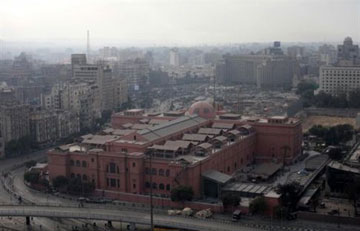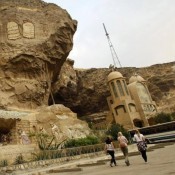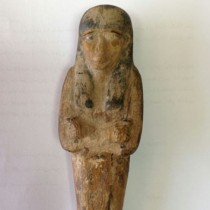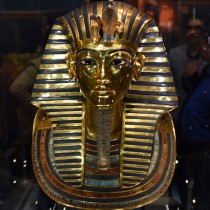Worsening conditions at the Cairo Museum are having a detrimental impact on the ancient artefacts it seeks to protect, according to an Ahram newspaper report.
Damages on the galleries’ interior decoration, windows fool of dirt, poor standards of hygene, tatty, half painted walls where self-made visitors’ signs printed in A4 paper are carelessly taped, whereas object labels are often absent or faulty. This is the present condition in one of the most significant museums worldwide, as the political and social situation in Egypt goes from bad to worse.
“Look at the Fayoum portraits, and the mummies exhibited, they are falling apart before our own eyes. They need restoration, but regretfully we don’t have enough money to do anything,” said Wafaa Habib, director of Greek and Roman Antiquities at the museum.”The exhibition of King Tutankhamun has travelled around the world, yet the museum provides no information, there must be some factual information somewhere,” said another museum curator.
Things are worse concerning the ancient artefacts themselves. “The manner in which the artefacts are currently displayed is damaging them. We don’t have money for the essential repair and conservation work,” said Habib, elaborating that necessary repairs need to be made; the mummies must be delicately removed from the showcases and repaired by the conservation department.
According to Habib, specific temperatures, special light and ultra violet glass is necessary to conserve the artefacts as sunlight is also damaging. The fragmenting of famous portraits from Sheikh Abada area in Al-Menia further demonstrates the deprivation, as does Habib’s mere request for a sum of LE4,000 ($573) to make urgent wood repairs. The portrait dates to the Roman Period (2nd century AD) and it was excavated by M. Gayet in 1899. The material is encaustic on wood. Museum staff also stressed that the lack of resource is as rudimentary as basic office supplies, such as paper, ink and printing equipment.
The disappearance of museum objects since the revolution is another worrying phenomenon.”Some bronze statues were returned just a month ago,” explained Ahmed Melawany, a 28-year-old police officer of the Tourism and Antiquities Police. Despite such mishaps, which most employees deny is a regular occurrence, the museum security system is applauded for successfully safeguarding the museum’s priceless antiquities.
“Some bronze statues were returned just a month ago,” explained Ahmed Melawany, a 28-year-old police officer of the Tourism and Antiquities Police. Despite such mishaps, which most employees deny is a regular occurrence, the museum security system is applauded for successfully safeguarding the museum’s priceless antiquities.
Lack of visitors’ information is another problem the Museum is facing. There is no website and no IT expert, while, according to TripAdvisor, visitors have to hire a guide in order to learn anything about the exhibits. Bureaucracy and contradictions between the Museum authorities and the Ministry of State for Antiquities have also eliminated any initiatives: although an Egyptian company offered to create a new website for free, its inability to connect with officials in the Ministry of State for Antiquities (MSA) has stalled the process.
Too many cooks spoil the broth
Since the revolution, the museum’s director, according to staff, has changed four times and is usually in office for about four to six months. At the moment there are three directors: Said Amer, head director, Lotfy Abdel-Hamid, an antiquities expert, and Mohamed Ali, head of general management and security.
To make things worse, leadership at the chief authority responsible for Antiquities in Egypt, as well as the authorιty’s nature itself, change all the time. Since the “fall” of Zahi Hawass, his position had been taken by Mohammed Abdel Fattah, Mostafa Amin, Mohammed Ibrahim and recently Ahmed Eissa, while the Supreme Council of Antiquities (SCA) was renamed as Ministry of State for Antiquities.Yasmine El-Shazly, head of Registration Collection Management and Documentation (RCMD) department, also drew attention to the managerial instability and corruption.
“The main problem remains – corruption – as we do not receive allocated funds from donors, such as United Nation for Education Science and Culture Organisation (UNESCO) and Japan’s International Cooperation Agency (JICA),” suggested Amira Ezzet from the restoration conservation department, highlighting her and fellow colleagues’ aspiration to establish an NGO to improve conditions.
In this regard, a “Friends” group is said to be underway, according to El-Shazly. This organisation is an NGO under the umbrella of Nahdet El-Mahrousa and will handle a variety of issues ranging from funding, sponsorship, hiring experts and staff empowerment. “The current lack of governmental resources after the revolution, reinforces the necessity to establish ‘friends’ groups, following in the footsteps of all museums around the world,” affirmed El-Shazly. The group also aims to develop educational spheres in the museum that target tourists as well as Egyptians, who are too often sidelined.
Discrimination towards Egyptians is another obstacle that requires attention, suggested the RCMD head. However, she concurrently admitted that prejudice has improved since the revolution, prior to when men wearing galabayas ‘cotton dress’ were not allowed.
Working conditions and civil responsibility
“I am not happy with my job, I work six days a week and I am paid LE700 ($100) per month and only have one change of uniform,” stated one of the female cleaners, highlighting the poor working conditions and underpayment. Lack of motivation and purpose was a common complaint expressed by most employees. The museum guards in charge of protecting the artefacts often juggle two jobs because of low government wages, thus often appearing lethargic and unmotivated. Mohamed Atta, a young civilian dressed security guard stressed that although internal conditions have deteriorated, the security remains strong.
In view of the current state of affairs within the museum, experts advise Egyptians to protect their heritage before the damage is irreparable or transferred into foreign hands as has occurred in the past. “Civil society’s role cannot be underestimated,” stressed El-Shazly.






